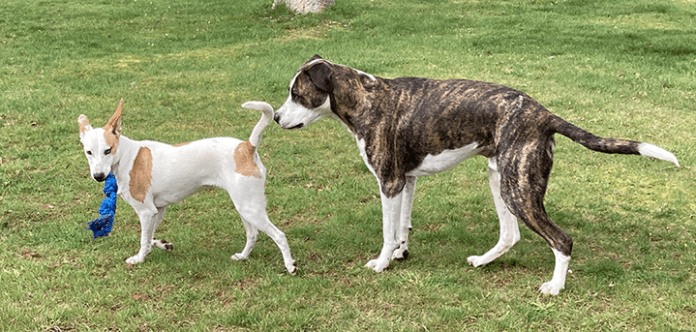Intact (unspayed) female dogs will typically have their first heat cycle two to three months after they reach their full adult size. For smaller breed dogs, this is typically between 6 and 8 months of age but could be as early as 4 months. For larger breed dogs, this may be as late as 2 years of age. Dogs can be in heat for an average of two to three weeks, going through a two-phase heat cycle.
How often do female dogs go into heat?
If they do not become pregnant as a result of mating during their heat cycle, most female dogs will experience another heat cycle in about six months. However, some dogs may start their next heat cycle as early as four months later and others as much as eight months later. If you have a purebred dog, find out what is typical for your breed. For example, the Basenji breed has only one heat cycle per year.
What to expect when your dog is in heat
Just before entering a heat cycle, dogs may:
- not have as much energy as usual
- their appetite may decrease
- they may become nervous and easily startled.
It is important to note that these signs can also accompany many illnesses that have nothing to do with a heat cycle. Please consult your veterinarian if you have any questions about changes in your dog’s behavior.
How long are dogs in heat and how long do they bleed?
Dogs have two phases to their heat cycle. During the first phase (called proestrus) there will be a bloody discharge from her vulva. Her vulva will become swollen and prominent. Male dogs will begin to show an interest in her. She may become aggressive toward male dogs during the first part of this phase. As this phase progresses, she will stop being aggressive toward male dogs but will sit down when they approach her. Proestrus lasts an average of nine days but can be as short as three days and as long as 17 days.
During the second phase (called estrus), the discharge from her vulva will become straw-colored but may have a hint of brown or red color. When approached by a male dog, she will stand and lift her tail over her back or held off to the side (this is called “flagging”). Her vulva will decrease in size but will still be swollen. When she is ready, she will allow a male dog to mount her for mating. Estrus lasts an average of nine days and can be as short as three days and as long as 18 days.
The total time of both phases of “heat” is about two to three weeks. The female dog will discontinue having discharge from her vulva by the end of the second phase and her vulva will slowly return to its original size.
If she and a male dog mated during estrus and she became pregnant, her pregnancy will last approximately 63 days (about nine weeks).
What is a silent heat in a female dog?
Some dogs may appear to miss one of their heat cycles, without exhibiting any obvious signs of proestrus or estrus, such as vulvar swelling or vaginal discharge, even when they are, in fact, experiencing those stages and can become pregnant. This is called a “silent cycle” or “silent heat.” Owners of intact females should be attentive to this possibility – and how often do dogs go into heat, how long do dogs bleed when they are in heat, what to expect when your dog is in heat – if they do not want the female to become pregnant.
How to prevent your dog from becoming pregnant
There are a number of surgeries that can be performed to prevent your dog from becoming pregnant. The most common “spaying” procedure is called an ovariohysterectomy – a surgical procedure in which her ovaries and uterus are removed. Some owners prefer their veterinarians to perform an alternative surgery called an ovariectomy, in which only the dog’s ovaries are removed. Ovariectomies are quicker to perform and dogs tend to recover more quickly, too.
In recent years, some studies have suggested that intact dogs have fewer health problems than dogs who matured without the influence of normal secondary sexual hormones on their development. However, the studies do not show a clear-cut correlation and there are variations by breed and size of the dog. Also, the increased risk of mammary cancer in intact females and late-spayed females has been very well established.
Owners who wish to prevent pregnancy in their dogs but also wish to preserve the source and influence of the female’s sexual hormones can look for a veterinarian who can perform tubal ligation surgery (where the dog’s fallopian tubes are cut and/or blocked) or a hysterectomy (where the uterus is removed but the ovaries are left in place).
Note that dogs who have retained their ovaries will continue to experience heat cycles and attract the attention of male dogs. They cannot become pregnant but will be receptive to mating when they are in estrus.
If a dog is currently in heat, you will need to wait until three weeks after her heat cycle has finished to have her spayed. This allows the uterus to return to its original size and reduces the risk of surgical complications.






Very useful, thank you.
The article says to wait three weeks after heat cycle to have spay surgery. My veterinarian recommended waiting two months.